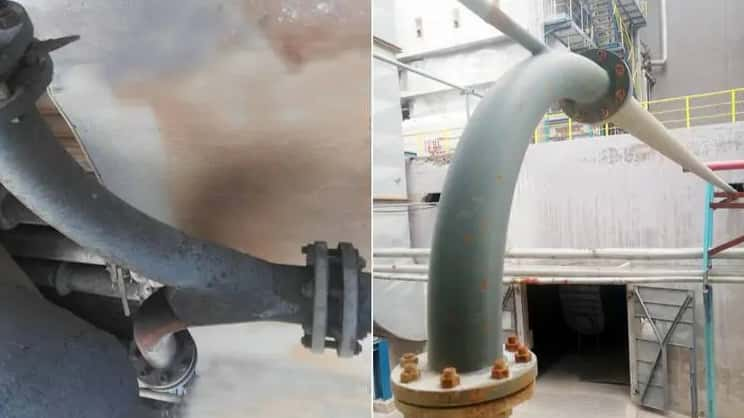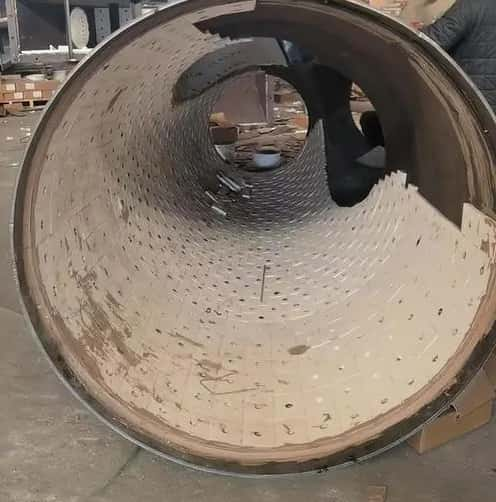Industries handling large volumes of dust or particulate matter—such as steel, cement, power generation, and mining—face the persistent challenge of managing dust effectively to ensure safe, efficient, and environmentally compliant operations. Central to these operations is the network of dust removal pipelines, which play a vital role in containing, transporting, and eliminating dust. However, these pipelines are subject to consistent wear due to dust particle impacts, erosion, and environmental stressors. Left unaddressed, pipeline wear can lead to costly repairs, frequent replacements, or even hazardous operational failures.
In this comprehensive guide, we explore the factors contributing to pipeline wear, delve into the specific anti-wear strategies that can prolong pipeline life, and discuss how emerging materials and design innovations are transforming dust management systems. By implementing these measures, industries can enhance operational efficiency, ensure environmental compliance, and safeguard employee safety.

Understanding where and why wear occurs in dust removal pipelines is critical to developing effective prevention strategies. Pipeline wear is typically concentrated in sections of high turbulence or increased dust flow impact, such as bends, tees, and junctions. Straight segments are generally less vulnerable, though they are not immune, as wear may still occur at the bottom of pipes where dust particles settle due to gravity.
System Leaks and Reduced Efficiency:
As pipelines wear, small fissures and leaks can develop, compromising the containment of dust. When system leaks occur, dust can escape into surrounding areas, posing health hazards and leading to environmental non-compliance. Additionally, leaks reduce the efficiency of dust collection systems, as air pressure is compromised.
Compromised Structural Integrity:
Over time, wear can weaken the structural integrity of pipelines, especially in elevated sections. A worn pipeline may lack the strength to withstand internal pressures, which can lead to system collapse or failure. For pipelines positioned above machinery or personnel, such failures pose serious safety risks.
System Malfunctions and Downtime:
Severe wear can degrade the functionality of dust removal systems, resulting in more frequent maintenance requirements and potential system shutdowns. Downtime in industries relying on continuous operation, like power plants or cement manufacturing, can lead to significant financial losses.
Coal-Fired Power Plants: Dust collection systems in power plants handle high volumes of abrasive coal dust. Over time, constant particle impact leads to erosion in elbows and tees, increasing system maintenance needs and causing unscheduled downtime.
Cement Manufacturing Facilities: Cement production involves grinding and transporting raw materials, creating a continuous flow of dust that erodes pipelines and reduces the efficiency of dust collection systems. The frequent need for repairs and replacement of worn pipes represents a major cost in cement production.
To implement effective anti-wear solutions, it’s essential to understand the primary factors that drive pipeline wear. By identifying and controlling these variables, industries can better manage the rate of wear and enhance the overall longevity of their dust removal systems.
The internal airflow velocity within dust removal pipelines is a determining factor in the rate of wear. Higher velocities increase the kinetic energy of dust particles, intensifying the impact force on the pipeline walls. However, airflow cannot always be reduced due to operational requirements, making it necessary to balance flow speed with wear-resistant measures.
Strategies to Mitigate High Airflow Velocity:
Installing flow restrictors or baffles at critical points to reduce velocity without compromising system function.
Using high-performance coatings on the inner pipe surfaces to absorb and distribute the impact of high-velocity particles.
Employing larger pipeline diameters where possible to reduce overall pressure and particle speed.
Dust concentration directly correlates with the amount of abrasive contact within the pipeline. Higher concentrations mean a greater frequency of particle-wall interactions, accelerating wear. Industries with high dust output, such as coal processing and mineral extraction, must monitor and manage concentration levels to minimize wear.
Dust Concentration Management Techniques:
Introducing filtration systems at the intake points to capture larger particles.
Modifying dust hood structures and extraction points to regulate the volume and speed of incoming dust, distributing particles evenly across the pipeline.
Installing multiple exit points in complex pipeline systems to prevent particle buildup in critical areas.
The angle at which particles impact the pipeline wall, known as the incidence angle, affects the degree of abrasion. Particles hitting the wall at sharper angles often cause more rapid wear due to direct impact. Adjusting this factor requires careful design modifications.
Engineering Solutions for Optimizing Incidence Angles:
Utilizing curved pipeline sections to reduce abrupt changes in direction, which lowers the angle of impact.
Adding liners or coatings specifically designed to withstand abrasive forces at acute angles.
Redesigning bends and tees to increase curvature, thereby reducing the sharpness of impact.
The friction coefficient between dust particles and the pipeline material determines the rate of abrasion. Harder particles, irregular shapes, or rough inner surfaces in the pipeline can exacerbate frictional wear. Understanding and managing these variables is crucial for designing resilient dust removal systems.
Material Selection to Lower Friction Coefficient:
Opting for smooth, wear-resistant surfaces like ceramic or Teflon linings that reduce friction.
Selecting pipeline materials with hardness levels that counteract abrasive forces, such as high-grade steel or ceramics for extremely hard dust particles.
Applying periodic maintenance coatings that maintain smoothness and prevent roughness from increasing over time.
Prolonging the life of dust removal pipelines involves a combination of material innovation, structural design optimization, and tailored maintenance practices. The following are widely adopted anti-wear measures designed to meet the demands of high-dust environments.
Airflow velocity has a direct impact on particle speed and, consequently, on wear rate. Adjusting and controlling airflow not only mitigates wear but also improves overall system performance by enhancing dust collection efficiency.
Practical Methods for Airflow Regulation:
Adjustable Duct Dampers: Installing dampers allows operators to control airflow velocity in different sections of the pipeline, maintaining optimal flow without causing excessive turbulence.
Sequential Airflow Control: In complex systems, employing staggered airflow rates can reduce wear at specific points. This method ensures that high-velocity sections are limited to areas designed to handle increased wear.
Pressure Drop Management: By controlling pressure drops within the pipeline, particularly in high-wear areas, the overall impact force of particles can be minimized.
The dust hood structure is the initial point where dust enters the removal system. Proper design of this structure ensures a controlled intake of dust particles, reducing the amount of large, abrasive particles that can damage the pipeline.
Design Improvements for Dust Hoods:
Positioning and Angle Adjustment: Placing dust hoods closer to dust generation points and at angles that align with natural particle flow can reduce turbulence and prevent larger particles from entering the pipeline.
Screened Entrances: Incorporating screens or filters at dust hood entrances helps capture larger particles that could lead to rapid wear in the pipeline.
Flow Control Valves: By installing valves at extraction points, the amount and speed of dust intake can be managed, ensuring a more balanced particle distribution.
Bends, tees, and joints are often the most vulnerable points in dust removal systems. These sections should be designed with an optimal bend radius and reinforced wall thickness to withstand the forces of particle impact.
Best Practices for High-Wear Areas:
Widened Bends: Using bends with larger radii spreads particle impact across a broader surface area, reducing localized wear. A bend radius increase of 1-2mm can make a notable difference in durability.
Thicker Wall Sections: For tees and joints, increasing wall thickness by a millimeter or more adds strength, allowing these points to absorb impact without rapid degradation.
Curved and Layered Designs: Layered designs with a hard outer shell and a shock-absorbing inner layer are increasingly popular in high-wear environments. This configuration absorbs impact forces while protecting the structural integrity of the pipeline.
One of the most effective anti-wear strategies is the use of wear-resistant materials for dust removal pipelines. Modern composite materials offer durability, resistance to corrosion, and ease of installation, making them ideal for pipelines that encounter constant abrasive contact.
Common Wear-Resistant Materials:
Ceramic-Lined Pipes: These pipes consist of a steel outer shell with an internal lining of alumina ceramic. Ceramic-lined pipes are popular for handling abrasive dust in industries like thermal power and metallurgy due to their resilience to high temperatures and wear.
Cast Iron and Cast Stone: Known for their durability, cast iron and cast stone pipes are used in areas with extreme abrasion. They are particularly effective in situations where large volumes of hard particles are transported.
Rubber-Lined and Coated Pipes: Rubber linings provide flexibility and impact absorption, making them suitable for sections where particles hit at high velocity. Rubber-lined pipes are commonly used in mining and material transport industries.
Polymer Coatings: Advanced polymers like polyethylene and Teflon can be applied as coatings within pipelines to reduce friction and offer a wear-resistant barrier.

The introduction of wear-resistant ceramic composite pipes has transformed dust management in several industries. With a steel exterior and ceramic-lined interior, these pipes offer the unique combination of toughness and high-temperature resistance that many high-dust environments require.
Extended Equipment Lifespan:
Ceramic-lined pipes can last up to 10 times longer than standard pipes, significantly reducing maintenance frequency and replacement costs. This longevity is particularly valuable in industries that rely on continuous operation.
Ease of Installation and Maintenance:
Ceramic composite pipes are designed with easy installation in mind, featuring standardized sizes and connections that allow for rapid replacement. This benefit minimizes downtime and operational disruption.
High Resistance to Temperature and Corrosion:
Ceramic materials withstand temperatures exceeding 1000°C, making these pipes ideal for industries that handle hot, abrasive dust. Their resistance to chemical corrosion also enhances their applicability in sectors like oil and chemical processing.
Thermal Power Plants: In coal-fired plants, ceramic composite pipes are used to transport fly ash, a highly abrasive byproduct. The pipes maintain durability under high temperatures, reducing replacement frequency and supporting consistent operation.
Steel and Metallurgy: Ceramic pipes are commonly used in the extraction and processing stages, where iron dust and other particulates cause rapid erosion. Their resilience ensures minimal disruption during production.
Cement Industry: The abrasive nature of cement dust can cause significant wear in traditional pipelines, but ceramic-lined pipes withstand the harsh conditions, preserving efficiency and reducing maintenance needs.
Proactively managing wear in dust removal pipelines is essential for maintaining safety, efficiency, and cost-effectiveness in dust-intensive industries. By implementing advanced engineering designs, selecting wear-resistant materials, and adhering to regular maintenance practices, companies can extend pipeline life, reduce operational costs, and improve dust collection efficiency.
The evolution of wear-resistant technology, particularly with ceramic composites, has redefined dust management standards across sectors. As industries continue to seek high-performance solutions, adopting a combination of these strategies ensures a sustainable approach to wear prevention and enhances the overall productivity of dust removal systems.

Submit your demand,
we will contact you ASAP.

Sanxin New Materials Co., Ltd. focus on producing and selling ceramic beads and parts such as grinding media, blasting beads, bearing ball, structure part, ceramic wear-resistant liners, Nanoparticles Nano Powder

